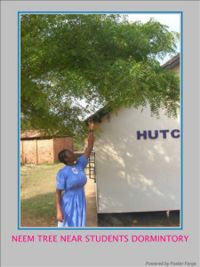More
MORE
CONSERVATION OF LOCAL MEDICINAL PLANTS
Contents
project by
Project contacted by: 13-15 year old students of Gayaza High School Supervised by: Milton Chebet, a teacher of Biology, Gayaza High School
Materials needed
- Camera
- Pens, writing paper, clipboards
- Hoe, panga, knife,
- Computers connected to internet
- Projector for presentations
Background
Herbal medicine is the use of plants-their leaves, stems, bark, flowers, fruits, and seeds to prevent or cure disease. Different cultures use herbs located in their geographical locations for curing common illnesses. Gayaza high school is rich with so many plant species, many of the plant species are medicinal/herbal meaning their leaves, stems, bark, flowers, fruits, and seeds can be used to prevent or cure disease. The school botanical garden alone has over 50 medicinal herbal plants; the trees and flower gardens in and around the school compound can be very useful in treatment of many diseases. The rate of degradation of medicinal plants and herbs around the school community is so high that if not conserved will face extinction. The knowledge of their existence is also lacking among the student and local population. The young generation is also lacking information about the existence of local medicinal plants; the knowledge of their existence is getting extinct with the older generation as many people are relying on manufactured medicine. Conservation of medicinal plants, especially endangered ones depend largely on the conservation of the ecosystem in which they occur and harnessing the knowledge of their existence and importance. Popular but slow growing and or naturally rare plant species are often under pressure. Sustainable management of medicinal plant species is important, not only because of their value as a potential source of new drugs but due to reliance on medicinal plants for health care. Growing these herbal plants in organized gardens may be one of the means of achieving medicinal plant conservation by reducing the exploitation pressure exerted on naturally occurring plant species. This protects plants that are being threatened in their natural habitats. Through organized gardens, propagation of the plants can easily be achieved. Naming of medicinal plants around the school compound with common name, scientific name, local name and what it cures will promote awareness on the values of the plants. Students through their participation in painting and writing on wooden boards get an opportunity of learning art skills
Objectives
|
Project activities
|
Students are tasked with taking photographs of the medicinal plants around school compound and school botanical garden.
|
what to look out for
- Nature of the herbal plants, (ie, tree, herb, shrub)
- Types of roots they posses,
- Type of stem,
- Type of leaves
- Flowers and fruits,
- Habitats occupied by these plants.
- Diseases they prevent or cure
- scientific name, local name, kingdom, phylum, class, order, family, genus, and species
other information to look for
- Students in their groups prepare PowerPoint presentations to be presented to students, teachers of schools from within.
- share work online with other students elsewhere within the community
- Development of propagation and cultivation methods and piloting of ex-situ cultivation of selected medicinal plants for treatment of major human diseases;
- Organizing and establishing propagation, cultivation and distribution of medicinal plants through the promotion of community-based nurseries which shall are distributed to the different homes
- Preparing a data base of medicinal plants and distributing to surrounding schools, research institutions and other institutions of higher learning.
An example of students work (data base)
data base and naming of medicinal plants
Common Name Neem Local name Niimu Scientific Name Azadirachta indica
parts of the plant that are medicinal
- leaves
- seeds
- bark
medicinal Uses
- Malaria
- cough
- Candida
- Boils
- Athletes foot
- Skin problems
- Dental carries
Classification
- Kingdom Plantae
- Division Magnoliophyta
- Class Magnoliopsida
- Order Sapindales
- Family Meliaceae
- Genus Azadirachta
- Species indica
Mango
classificaton
common name : Mango= local name : muyembe 'scientific name: Mangifera indica 'diseases cured
- cough
- KINGDOM-Plantae
- PHYLUM-Magnoliophyta
- CLASS-Magnoliophyta
- ORDER-Sapinadales
- FAMILY-Anacardiceae
- GENUS-Magnifera
- SPECIES Indica Indica
